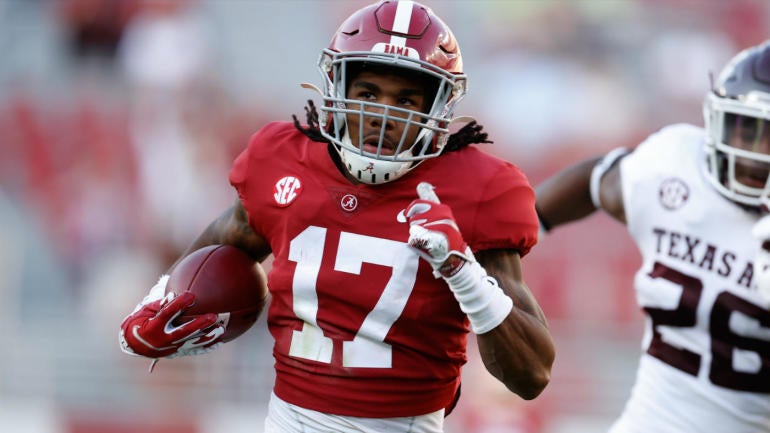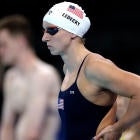
Who would've ever thought Alabama, coached by defensive oracle Nick Saban, would stake its claim as wide receiver university? In 2020, absolutely anything is possible, and here we are, with the Crimson Tide positioned for two receivers landing inside the first round in back-to-back years, something of course that has never ever happened before.
After a pair of heroic performances from Jaylen Waddle and Devonta Smith in the colossal win over Georgia Saturday night, we figured it'd be an appropriate time to compare and rank recent wideout prospects from Alabama. Of course, for Waddle and Smith, more games are to be played at the collegiate level, but they've been so good for so long now, it seems like we already know exactly what the NFL will be getting with both pass catchers.
Yes, Julio Jones was the pioneer in Alabama's journey to serious WR U contention, but because I wasn't scouting draft prospects in 2011 -- and 2011 isn't exactly "recent" -- he's being omitted. But, I'm confident writing Jones was the finest receiver prospect of anyone listed below. The perfect wideout specimen. He was a unicorn prospect.
6. Calvin Ridley, 2018
I was never quite as high on Ridley as the masses. In the 2018 class, he was my WR6 and No. 46 overall prospect. I was worried about his age -- turned 24 near the end of his rookie year -- and how it likely helped him against younger defensive backs in the SEC during his career at Alabama. I compared him to Robert Woods and wrote the following on that comparison before the draft: "Woods has carved out a nice career with sharp route running, reliable hands, and good downfield speed. Ridley is a flashier route-runner than Woods but has a similar athletic profile and, like the former USC star, isn't a consistently dynamic make-you-miss wideout with ball in his hands."
He was a difficult evaluation because of the quality of his quarterback play, which certainly has not been a problem for receivers at Alabama of late. Throwing Ridley the football in college was Jake Coker and freshman and sophomore year Jalen Hurts. Ridley was a polished route runner as a freshman -- his most productive season with the Crimson Tide -- but beyond his age, his lack of YAC skills worried me. But maybe he just didn't get enough opportunities in his final season at Alabama when he infamously only forced two missed tackles on 63 receptions. At nearly 6-1 but just 189 pounds, he ran 4.43 at the combine. However, Ridley had a broad and vertical in the seventh and second percentiles respectively among receivers. Red flag city. But his 6.88 time in the three cone was very good.
After consecutive 800-plus yard receiving seasons with 17 total touchdowns, Ridley is on pace to set career highs across the board in 2020. And Julio's presence probably helps and hurts him. The third-year receiver is guaranteed to see No. 2 cornerbacks -- when Jones is healthy -- but Jones eats into his target share. To me, Ridley has outplayed how good he truly was as a prospect, but I wouldn't call him a home run of a first-round pick.
5. Henry Ruggs, 2020
Ruggs' speed elevated him to the top half of 2020 draft. There's no doubting that. But, he did land in Las Vegas with twitch and relatively smooth route-running capabilities, along with an occasional flash of contested-catch brilliance. He was my No. 4 wideout but No. 14 overall prospect in the 2020 class.
And how he's fared thus far with the Raiders is nearly a replica of what he did at Alabama -- low volume, high impact. With the Crimson Tide, Ruggs scored 25 touchdowns on 98 career touches, a preposterous rate of putting the football in the end zone. He's only played in three games and has just 11 targets. But he's caught six passes for 177 yards with four first downs and one score. On paper, Ruggs should be Tyreek Hill 2.0, and maybe he'll ultimately become that type in the NFL. While he played with three other first-round picks at receiver at Alabama, it was hard to peg why Ruggs wasn't more involved in the offense on a more regular basis.
At times he got physically over-matched by longer, more powerful cornerbacks because he's 5-11 and 188 pounds, and he wasn't a tremendous separator on intricate routes despite his athletic prowess. Ruggs' game-altering speed was the trump card that led to him being the first wideout off the board in the 2020 draft. He has all the tools to ultimately be better than this ranking, but as the fact that he had six games with three or fewer catches in his final season at Alabama indicates, Ruggs was more flash than substance as a prospect.
4. Devonta Smith, 2021
Smith grows on me with each game I watch him play. And I feel like if you saw Smith in person, you'd never believe he was arguably the best wideout in the country and will likely leave Tuscaloosa as Alabama's all-time leader in receiving yards. At 6-1 and 175 pounds, Smith is the definition of spindly, but he just gets open. On seemingly every play. And I'll tell you why.
He's a master combating press coverage with his feet and hands in unison. From there, he has good acceleration and uses a variety of fakes -- including changing speeds -- and erupts out of his breaks to run away from cornerbacks. He tracks the football down the field and in the end zone from in close phenomenally. Is a true burner? No. I don't think Smith's a high 4.5 guy either. I've seen some Marvin Harrison comparisons on Twitter, and I'm not quite there yet with Smith, but honestly, I'm trending in that direction. He legitimately was the best, most complete wideout on the field with Jeudy and Ruggs, which is bananas when you really think about it. Smith's had over 50 yards in 17 of his last 21 games, which includes six 100-plus yard outings.
3. Jerry Jeudy, 2020
Jeudy's explosion as a true sophomore put him on the first-round radar. Jeudy was a five-star recruit coming out of high school and absolutely met the hype. He was my WR2 and No. 8 overall prospect in the 2020 class after a dazzling career at Alabama. Winning the Biletnikoff Award as the best wideout in college football at 19 years old was telling. Jeudy has looked like a veteran receiver with the violence at which he runs his routes since he stepped on the field at Alabama.
Simply using the word "sudden" is selling Jeudy's movements short. And in college, he wasn't just a raw athletic flailing all over the place. There was an abundance of subtlety to his route-running style, and how he destroyed press at the line of scrimmage. Plus, with 4.45 speed, he was a threat to score on any play and tracked it pretty well. His lanky frame, 6-1 and 193 pounds, disappointing performances in the vertical and broad along with a disastrously slow short-shuttle drill were the only legitimate knocks on his game. And maybe that after the catch, Jeudy wasn't quite as productive as his athleticism indicated he would be. But that's all nit-picking. Jeudy was a fascinating wideout prospect who projected wonderfully to the modern-day, separation-based NFL.
2. Amari Cooper, 2015
Cooper was my WR1 in the 2015 draft -- before my days at CBS Sports -- and I dug up my quick scouting report on him in an old Google Sheet. I wrote the following about Cooper's game: "Extremely quick and fast but not 4.3 type. Perfect, sharp routes. Field stretcher who'd also work wonders in WCO. Hands aren't a major issue. Improved jump-ball skills during his Alabama career but isn't a stud in that area." I compared him to Victor Cruz.
One of the original "Phenom Index" stars -- a metric that combines age and receiving-yard market share -- Cooper accounted for a rather large 34% of Alabama's receiving yards as an 18-year-old freshman -- my gawd -- then a gigantic 44% as a 20-year-old junior. Everything from his route-running intricacies to stellar concentration on catches throws in traffic to his electric yards-after-the-catch abilities indicated Cooper was bound for stardom in the NFL. His hands were suspect at times. That was the lone ding on his prospect profile. At a compact 6-1 and 211 pounds, which certainly is NFL-ready size, Cooper ran 4.42 with a blisteringly fast 6.71 three cone. Cooper was an exquisite receiver prospect.
1. Jaylen Waddle, 2021
Waddle has it all. He looks about as fast Ruggs, runs crisp routes like Jeudy, and his ball skills are the same caliber as Cooper and Smith. All of that is why he's No. 1 in my rankings at the moment. I don't expect a sudden deterioration in talent from Waddle, and right now, he's challenging opt out Ja'Marr Chase for WR1 status in the 2021 draft. He's that dynamic and well-rounded.
Remember, in 2018 as a true freshman, when Jeudy won the Biletnikoff, Waddle accumulated 848 yards on just 246 routes run. Is that good? Glad you asked. It equates to a yards-per-route-run (YPRR) figure of 3.44, which was the fourth-highest in all of FBS that year (among receivers who ran at least 200 routes) and actually higher than Jeudy's YPRR figure of 3.19.
Waddle's built to be a YAC monster, as we've come to realize the stockier, compact offensive players are best in that area (think Deebo Samuel and A.J. Brown). Being 5-10 and 182 pounds is compact for a slot wideout, and we've seen Waddle ace his tests on the outside through four games. On 38 routes near the boundary, Waddle has eight grabs on 10 targets for 90 yards. His elite vision and jagged movements with the football in his hands provide a gadget-y, underneath element to his game, and he now has eight receiving scores of 50-plus yards in his Crimson Tide career (!) along with three return touchdowns. He's a big play waiting to combust.
(All advanced stats courtesy of TruMedia unless otherwise noted)

















